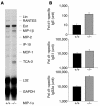Macrophage inflammatory protein-1alpha as a costimulatory signal for mast cell-mediated immediate hypersensitivity reactions
- PMID: 15650768
- PMCID: PMC544033
- DOI: 10.1172/JCI18452
Macrophage inflammatory protein-1alpha as a costimulatory signal for mast cell-mediated immediate hypersensitivity reactions
Abstract
Regulation of the immune response requires the cooperation of multiple signals in the activation of effector cells. For example, T cells require signals emanating from both the TCR for antigen (upon recognition of MHC/antigenic peptide) and receptors for costimulatory molecules (e.g., CD80 and CD60) for full activation. Here we show that IgE-mediated reactions in the conjunctiva also require multiple signals. Immediate hypersensitivity reactions in the conjunctiva were inhibited in mice deficient in macrophage inflammatory protein-1alpha (MIP-1alpha) despite normal numbers of tissue mast cells and no decrease in the levels of allergen-specific IgE. Treatment of sensitized animals with neutralizing antibodies with specificity for MIP-1alpha also inhibited hypersensitivity in the conjunctiva. In both cases (MIP-1alpha deficiency and antibody treatment), the degranulation of mast cells in situ was affected. In vitro sensitization assays showed that MIP-1alpha is indeed required for optimal mast cell degranulation, along with cross-linking of the high-affinity IgE receptor, FcepsilonRI. The data indicate that MIP-1alpha constitutes an important second signal for mast cell degranulation in the conjunctiva in vivo and consequently for acute-phase disease. Antagonizing the interaction of MIP-1alpha with its receptor CC chemokine receptor 1 (CCR1) or signal transduction from CCR1 may therefore prove to be effective as an antiinflammatory therapy on the ocular surface.
Figures







Similar articles
-
MIP-1alpha[CCL3] acting on the CCR1 receptor mediates neutrophil migration in immune inflammation via sequential release of TNF-alpha and LTB4.J Leukoc Biol. 2005 Jul;78(1):167-77. doi: 10.1189/jlb.0404237. Epub 2005 Apr 14. J Leukoc Biol. 2005. PMID: 15831559
-
Blocking mast cell-mediated type I hypersensitivity in experimental allergic conjunctivitis by monocyte chemoattractant protein-1/CCR2.Invest Ophthalmol Vis Sci. 2009 Nov;50(11):5181-8. doi: 10.1167/iovs.09-3637. Epub 2009 Jun 24. Invest Ophthalmol Vis Sci. 2009. PMID: 19553621
-
FcepsilonRI-alpha siRNA inhibits the antigen-induced activation of mast cells.Iran J Allergy Asthma Immunol. 2009 Dec;8(4):177-83. Iran J Allergy Asthma Immunol. 2009. PMID: 20404387
-
Pathophysiology of ocular allergy: the roles of conjunctival mast cells and epithelial cells.Curr Allergy Asthma Rep. 2002 Jul;2(4):332-9. doi: 10.1007/s11882-002-0062-6. Curr Allergy Asthma Rep. 2002. PMID: 12044270 Review.
-
[Immunoglobulin-like receptor, allergin-1 regulates the activation of mast cells].Arerugi. 2013 Nov;62(11):1451-7. Arerugi. 2013. PMID: 24552759 Review. Japanese. No abstract available.
Cited by
-
Ablation of type I hypersensitivity in experimental allergic conjunctivitis by eotaxin-1/CCR3 blockade.Int Immunol. 2009 Feb;21(2):187-201. doi: 10.1093/intimm/dxn137. Epub 2009 Jan 15. Int Immunol. 2009. PMID: 19147836 Free PMC article.
-
TRPM7 kinase activity regulates murine mast cell degranulation.J Physiol. 2016 Jun 1;594(11):2957-70. doi: 10.1113/JP271564. Epub 2016 Jan 27. J Physiol. 2016. PMID: 26660477 Free PMC article.
-
The Relationship between Chemokine Ligand 3 and Allergic Rhinitis.Cureus. 2020 Apr 22;12(4):e7783. doi: 10.7759/cureus.7783. Cureus. 2020. PMID: 32461855 Free PMC article.
-
Altered expression of long noncoding RNAs regulating neutrophilic inflammation in peripheral blood was associated with symptom severity in patients with house dust mite-induced allergic rhinitis.Front Allergy. 2024 Oct 25;5:1466480. doi: 10.3389/falgy.2024.1466480. eCollection 2024. Front Allergy. 2024. PMID: 39525400 Free PMC article.
-
Administration of JTE013 abrogates experimental asthma by regulating proinflammatory cytokine production from bronchial epithelial cells.Respir Res. 2016 Nov 9;17(1):146. doi: 10.1186/s12931-016-0465-x. Respir Res. 2016. PMID: 27829417 Free PMC article.
References
-
- Galli, S.J., and Lantz, C.S. 1999. Allergy. In Fundamental immunology. 4th edition. W.E. Paul, editor. Lippincott-Raven. Philadelphia, Pennsylvania, USA. 1127–1174.
-
- Sallusto F, Mackay CR, Lanzavecchia A. Selective expression of the eotaxin receptor CCR3 by human T helper 2 cells. Science. 1997;277:2005–2007. - PubMed
MeSH terms
Substances
LinkOut - more resources
Full Text Sources
Molecular Biology Databases
Research Materials

